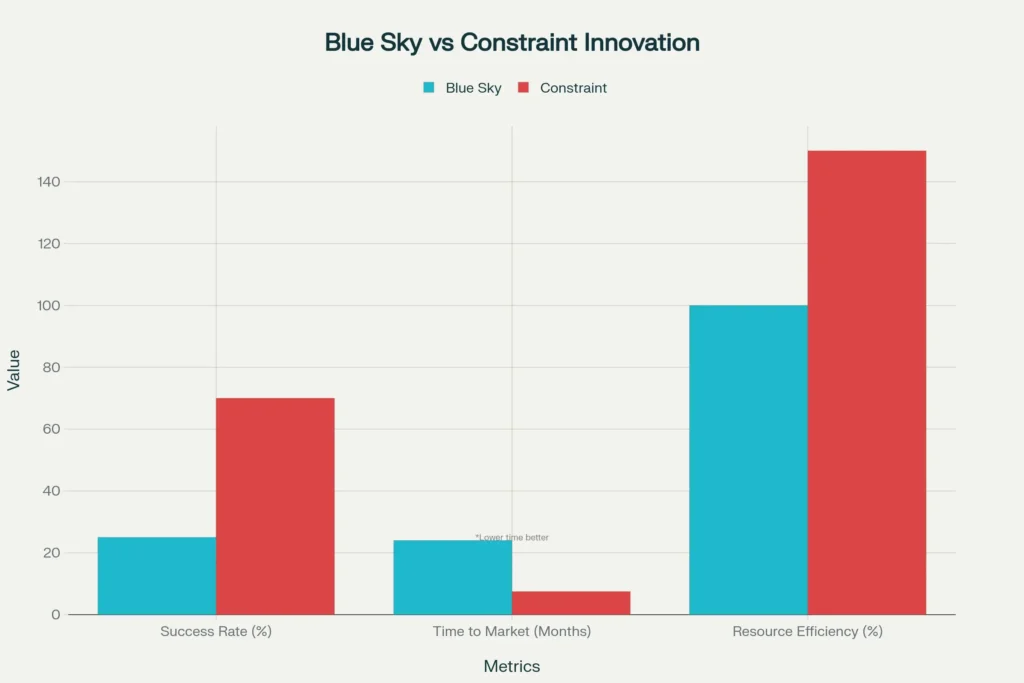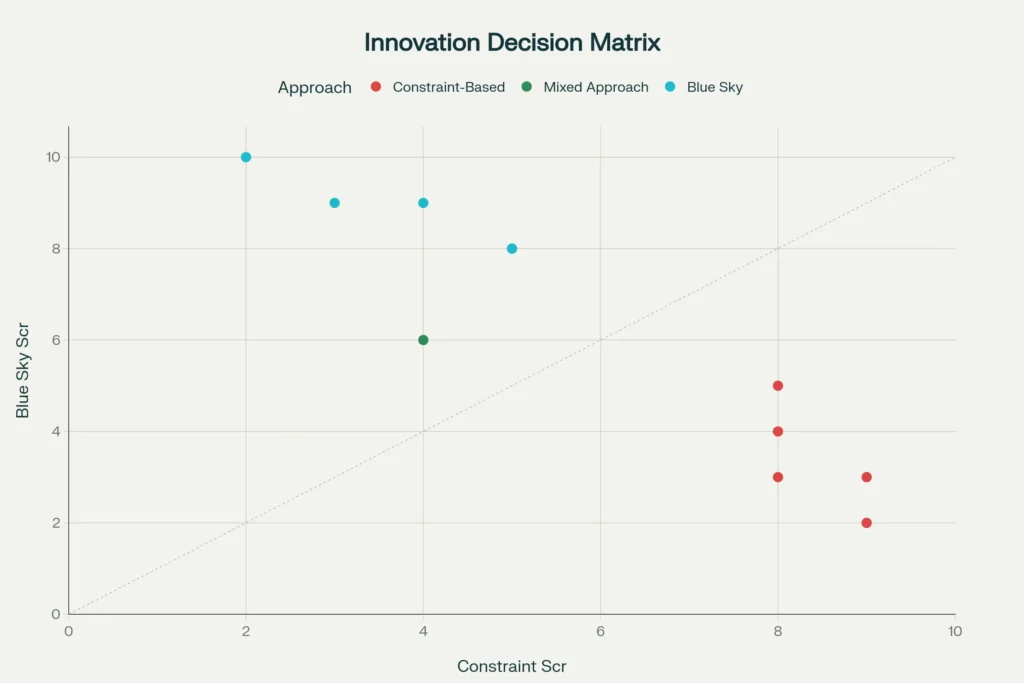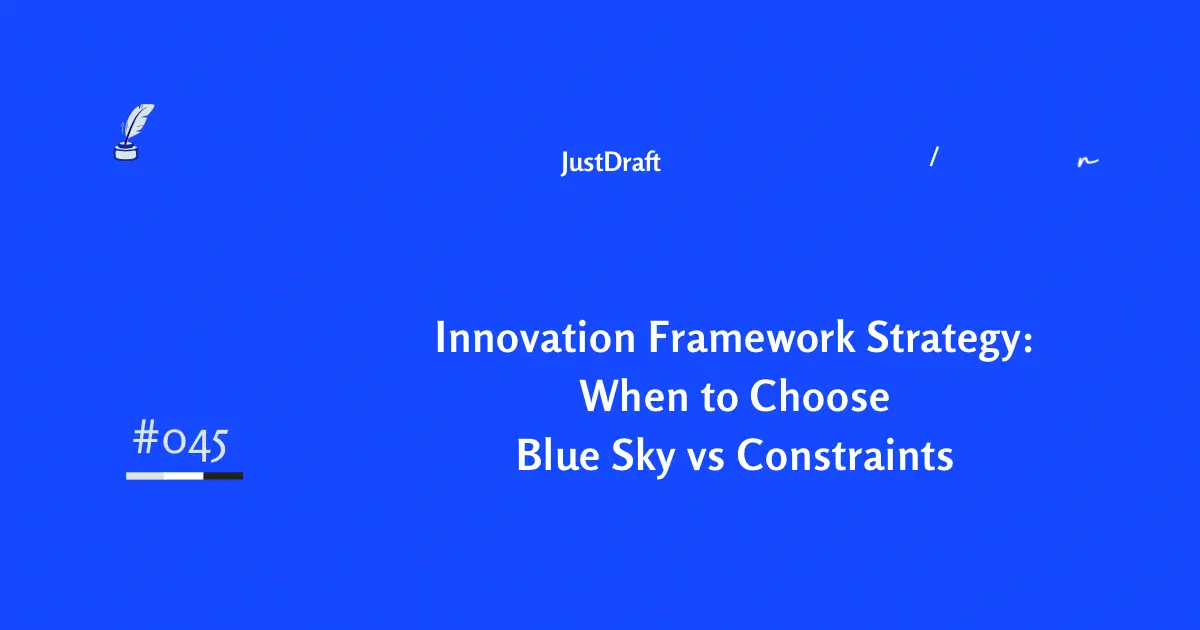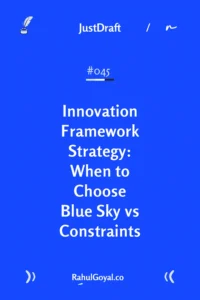Innovation Framework Strategy: When to Choose Blue Sky vs Constraints
Picture two teams in a workshop.
Team A gets an unlimited budget, no deadlines, and a whiteboard that says “Dream Big.”
Team B gets $1,000, two weeks, and a list of non-negotiables.
Who creates something amazing? More often than not—it’s Team B.
That’s because innovation isn’t about having endless resources. It’s about using the right approach at the right time.
One Topic: Blue Sky Thinking vs Constraint-Based Innovation
The Numbers That Will Change Your Mind
Here’s what surprised me most: Projects with clear constraints succeed 60-80% of the time. Blue sky projects? Only 20-30% make it to market.
But here’s the twist that keeps me fascinated – when blue sky projects actually work, they create entire industries.
Amazon’s “what if we sold everything online” was pure blue sky thinking in 1994.
Google’s “organize all the world’s information” sounded impossible.
These crazy ideas built trillion-dollar companies. The secret isn’t choosing one approach over the other. It’s knowing when to use each tool.
Understanding Both Mindsets
- Blue Sky Thinking is like giving a chef unlimited ingredients and saying “create something amazing.” No rules, no boundaries, just pure creative freedom. This is where breakthrough innovations are born.
- Constraint-Based Innovation is like Iron Chef – you get mystery ingredients, limited time, and specific requirements. The pressure forces creativity you didn’t know you had. Most leaders pick their favorite and stick with it. That’s their biggest mistake.

When Blue Sky Thinking Creates Magic
Use blue sky approaches when you’re:
- Breaking new ground: Creating products or services that don’t exist yet
- Facing existential threats: When incremental improvements won’t save youBuilding long-term advantages: Projects with 18+ month timelines
- Disrupting established markets: When conventional thinking keeps everyone trapped
When Mukesh Ambani decided to build Jio, everyone thought or said it was impossible. The infrastructure costs alone would bankrupt most companies. But that blue sky thinking created India’s largest telecom network and changed how 1.3 billion people use the internet.

When Constraints Spark Breakthrough Result
Here’s what most people miss:
Some of history’s greatest innovations came from working within tight limits, not despite them. WhatsApp’s founders had limited funding, so they focused on one thing – messaging that just worked. That constraint helped them avoid feature bloat and build something 2 billion people use daily.
Use constraint-based innovation when you:
- Need quick wins: 3-6 month projects
- Have limited resources: Budget, time, or talent constraints
- Want to improve what exists: Making current processes better
- Face regulatory requirements: Working within compliance rules
The Advanced Strategy: Combine Both
The smartest leaders don’t choose sides. They use both approaches in sequence.
Start with 90 minutes of blue sky brainstorming – no limits, no judgments, just wild ideas. Then switch to constraint mode: “Now make this happen with our actual budget and timeline.” This combination produces 40% better solutions than using either approach alone, according to research from Stanford’s d.school.
Apple does this well: revolutionary product ideas paired with strict design rules. Research shows creativity improves 10% when both are combined versus using just one.

Three Ways to Start This Week
- Try the Sprint Method: Give your team 60 minutes of pure brainstorming, then 60 minutes to solve it with specific limitations. The contrast creates breakthrough thinking.
- Use the 70-20-10 rule: Spend 70% of innovation efforts on constrained improvements, 20% on emerging opportunities, 10% on blue sky bets.
- Create artificial constraints: Ask “How would we solve this with half the budget?” Even when resources aren’t limited, constraints force creative solutions.
Your Next Move?
Companies that master both approaches don’t just survive market changes – they create them. They know when to remove all limits and when limits remove all excuses.
The data is clear: 67% of leaders who use this framework report significant ROI improvements within 12 months. They stop wasting time on the wrong approach and start getting results faster.
Stop asking “Should we think big or work within constraints?” Start asking “What does this specific challenge need right now?” Your breakthrough is waiting. The question is which tool you’ll use to find it.

Read last week’s LensLetter newsletter about Why Pros Still Use Lens FiltersValue of lens Filter in Photography.
Interested in travel, Read last week’s JustDraft about OKRs and KPIs.
Two Quotes to Inspire
Great leaders don’t choose between dreaming big and working smart – they master the timing of when to do each.
The absence of limits breeds imagination, but the presence of limits breeds ingenuity.
One Passage From My Bookshelf
The fundamental activity of a startup is to turn ideas into products, measure how customers respond, and then learn whether to pivot or persevere. All successful startup processes should be geared to accelerate that feedback loop. Startups exist not to deliver just a product, but to learn how to build a sustainable business. This learning can be validated scientifically by running frequent experiments that allow entrepreneurs to test each element of their vision.
📚 From The Lean Startup by Eric Rie

